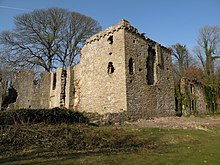Candleston Castle
| Candleston Castle | |
|---|---|
| Merthyr Mawr, Wales | |

Candleston Castle, view from south of the 14th-century tower, to rear. Left the hall and domestic range, from the middle of which projects to left the 17th-century west wing. To right of the tower is the stable block, c. 1800.
|
|
| Coordinates | 51°28′57″N 3°37′38″W / 51.4825°N 3.6273°WCoordinates: 51°28′57″N 3°37′38″W / 51.4825°N 3.6273°W |
| Grid reference | grid reference SS871772 |
| Site history | |
| Materials | Stone |
Candleston Castle is a 14th-century fortified manor house, in ruins since the 19th century. It is .75 miles (1.21 km) southwest of Merthyr Mawr, former Glamorgan, Wales, now Bridgend county borough and just .75 miles (1.21 km) northwest of Ogmore Castle, separated by the River Ogmore. Candleston's original long and narrow rectangular structure lay across the western end of a low narrow promontory, suggesting a defensive position. The castle is believed to be named after the Norman family of Cantilupe, thought to be its first feudal tenants.
The ruins of Candleston, which had been part of a medieval settlement, stand on the Merthyr Mawr Sand Dunes, on the edge of the Merthyr Mawr Warren. They are east of Porthcawl off of Swansea Bay.
In the 12th century, Candleston manor passed to the St Quintin lords of Talyfan and Llanbleddian; The Cantilupe family are considered Candleston's first tenants. Although there are no records to show that the de Cantilupes were at the site in the 12th century, it is believed that the de Cantilupe family were the original tenants and that the name Candleston is derived from their name, variously spelled Cantulupo, Cantilupo, Cantelo. In 1596 it was called Cantelowstowne and in 1635 Cantloston. It was Tregantlow in Welsh, Tref or Tre meaning town.
Candleston Castle, a fortified manor, was built in the 14th century. An enclosure, in the shape of a D, surrounded the structure. The late-medieval manor may have been constructed on the site of a previous building, based upon the presence of remnants of an earlier wall. The castle may have been built by Robert de Canteilupe III, who owned one ploughland at Candleston in 1320 according to the Despenser Survey of Glamorgan of that year. Robert III, who is not recorded after 1320, may have been succeeded by John de Cantilupe, who may have been the Abbot of Margam in 1315. Robert de Cantilupe III's daughter Joan, heiress of Candleston, married Sir William Horton of Tregwynt, Pembrokeshire.
...
Wikipedia

